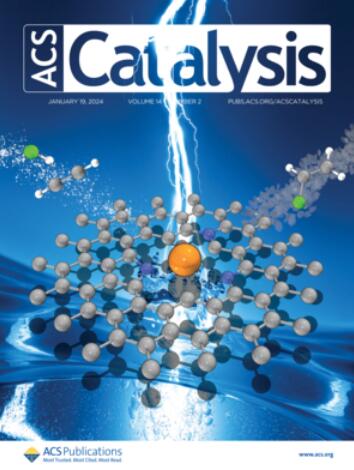Glutathione S-Transferase Mediated Epoxide Conversion: Functional and Structural Properties of an Enantioselective Catalyst
IF 11.3
1区 化学
Q1 CHEMISTRY, PHYSICAL
引用次数: 0
Abstract
Styrene is a naturally occurring but mainly anthropogenically produced aromatic compound. It is degraded via different routes in nature but often activated to styrene oxide, predominantly to its (S)-enantiomer. Hence, downstream enzymes should have regio- and enantio-preference. We have now demonstrated the enantioselectivity for a previously unknown class of bacterial glutathione S-transferases (GST) using both structural and kinetic approaches. Four actinobacterial GSTs were tested for their activity and selectivity. The most promising enzyme, GrStyI from Gordonia rubripertincta CWB2, was further investigated regarding its enantioselectivity and unique structure. GrStyI occurs as a homodimer and accepts (S)-styrene oxide (76 ± 3 μmol min–1 mg–1). It appears to be promiscuous in terms of structurally related epoxides and efficient for kinetic racemic resolution, providing a means for simple access toward (R)-epoxides, as we show in this study. We propose the presence of enantioselective GSTs in actinobacteria, forming the class of Actino-like GSTs.谷胱甘肽s -转移酶介导的环氧化物转化:对映选择性催化剂的功能和结构性质
苯乙烯是一种自然存在但主要是人为产生的芳香化合物。它在自然界中通过不同的途径降解,但通常被活化成苯乙烯氧化物,主要是它的(S)-对映体。因此,下游酶应该具有区域和对映体偏好。我们现在已经证明了一种以前未知的细菌谷胱甘肽s -转移酶(GST)的对映体选择性,使用结构和动力学方法。对4种放线菌的GSTs进行了活性和选择性测试。对最有希望的酶GrStyI进行了进一步的研究,以确定其对映选择性和独特的结构。GrStyI以同二聚体形式存在,接受(S)-苯乙烯氧化物(76±3 μmol min-1 mg-1)。就结构相关的环氧化物而言,它似乎是混杂的,并且对动力学外消旋拆分有效,为(R)-环氧化物提供了一种简单的途径,正如我们在本研究中所展示的那样。我们提出在放线菌中存在对映选择性GSTs,形成一类放线菌样GSTs。
本文章由计算机程序翻译,如有差异,请以英文原文为准。
求助全文
约1分钟内获得全文
求助全文
来源期刊

ACS Catalysis
CHEMISTRY, PHYSICAL-
CiteScore
20.80
自引率
6.20%
发文量
1253
审稿时长
1.5 months
期刊介绍:
ACS Catalysis is an esteemed journal that publishes original research in the fields of heterogeneous catalysis, molecular catalysis, and biocatalysis. It offers broad coverage across diverse areas such as life sciences, organometallics and synthesis, photochemistry and electrochemistry, drug discovery and synthesis, materials science, environmental protection, polymer discovery and synthesis, and energy and fuels.
The scope of the journal is to showcase innovative work in various aspects of catalysis. This includes new reactions and novel synthetic approaches utilizing known catalysts, the discovery or modification of new catalysts, elucidation of catalytic mechanisms through cutting-edge investigations, practical enhancements of existing processes, as well as conceptual advances in the field. Contributions to ACS Catalysis can encompass both experimental and theoretical research focused on catalytic molecules, macromolecules, and materials that exhibit catalytic turnover.
 求助内容:
求助内容: 应助结果提醒方式:
应助结果提醒方式:


